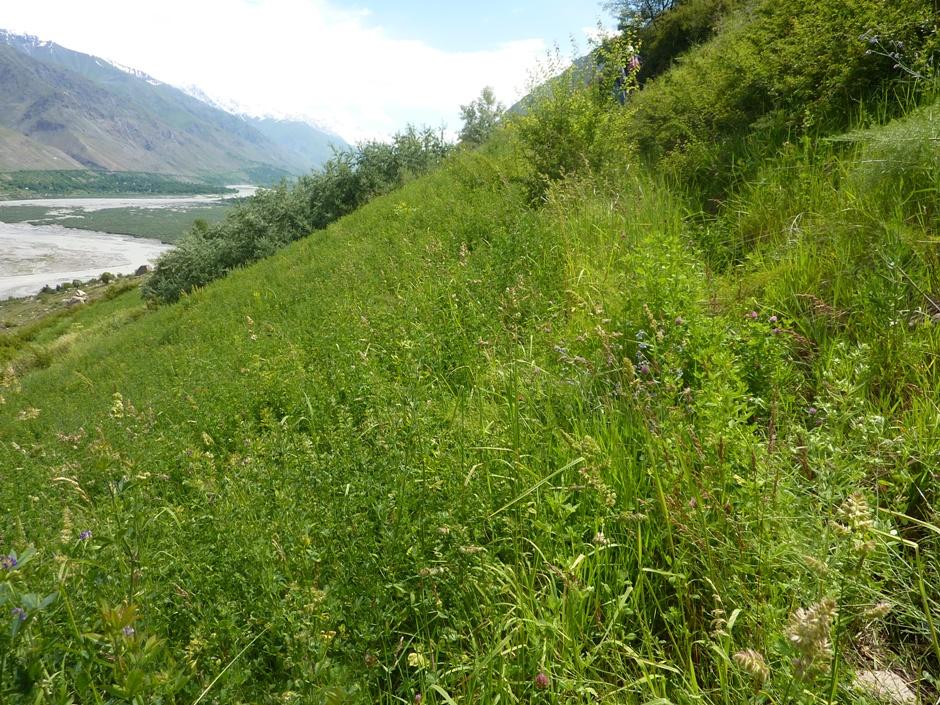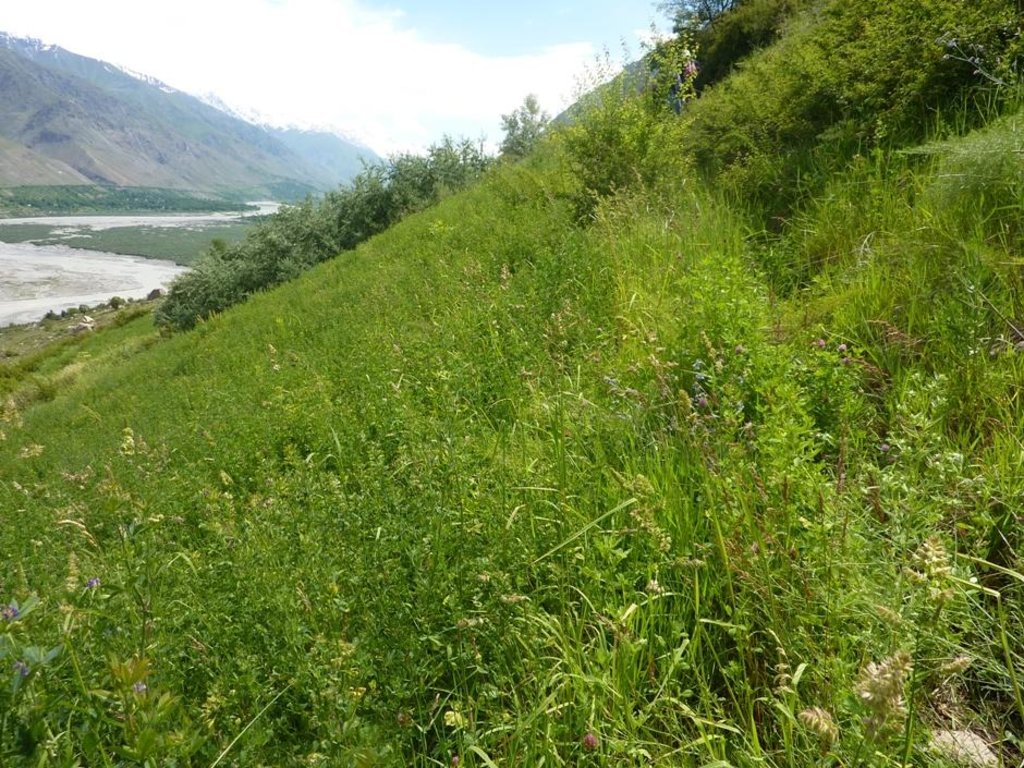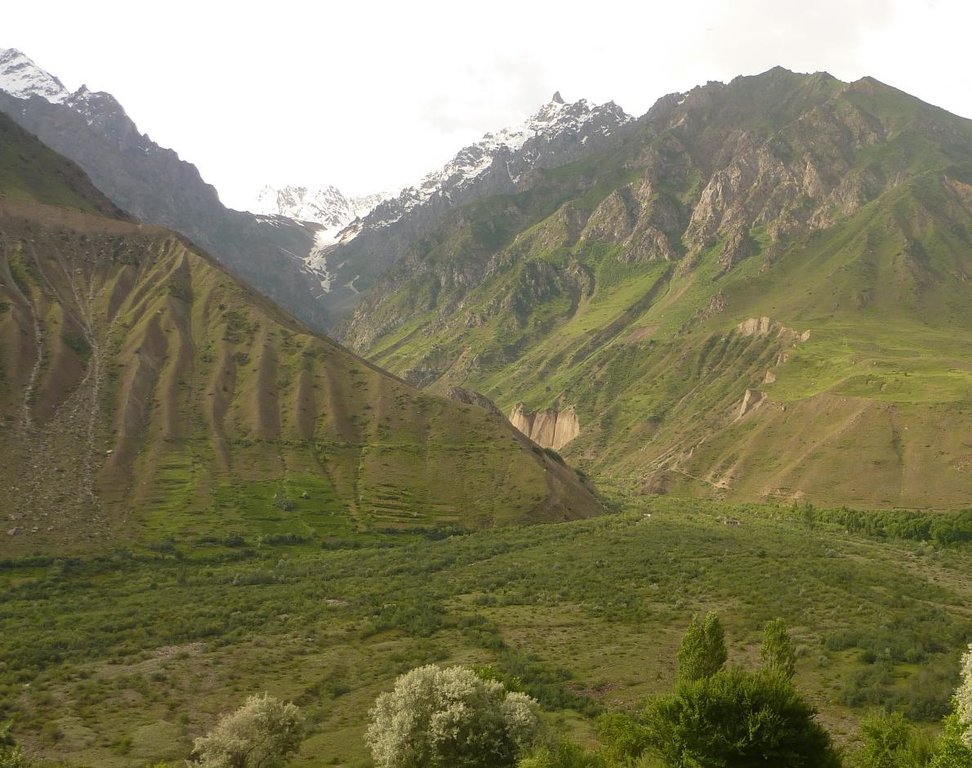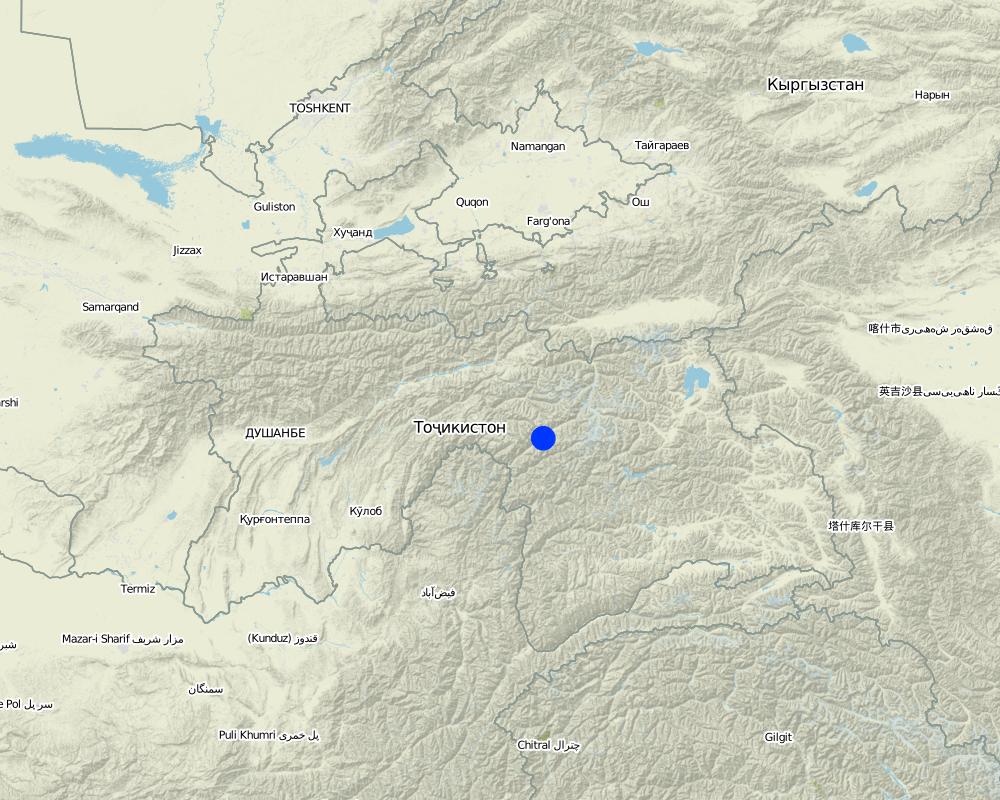Growing of fodder crops on steep slopes in arid highlands [Tajiquistão]
- Criação:
- Atualização:
- Compilador/a: Gulniso Nekushoeva
- Editor: –
- Revisores: Alexandra Gavilano, David Streiff
Парвариши алафхои бисьерсола (юнучка) дар нишебихои ростфуромадагии минтакахои баландкухои хушк
technologies_1028 - Tajiquistão
- Resumo completo em PDF
- Resumo completo em PDF para impressão
- Resumo completo no navegador
- Resumo completo (sem formatação)
- Growing of fodder crops on steep slopes in arid highlands: 2 de Novembro de 2021 (public)
- Growing of fodder crops on steep slopes in arid highlands: 14 de Agosto de 2019 (inactive)
- Growing of fodder crops on steep slopes in arid highlands: 19 de Julho de 2017 (inactive)
- Growing of fodder crops on steep slopes in arid highlands: 19 de Julho de 2017 (inactive)
- Growing of fodder crops on steep slopes in arid highlands: 14 de Março de 2017 (inactive)
Veja as seções
Expandir tudo Recolher tudo1. Informação geral
1.2 Detalhes do contato das pessoas capacitadas e instituições envolvidas na avaliação e documentação da tecnologia
Especialista em GST:
usuário de terra:
Gulomshoev Burkhvalisho
Tajiquistão
Nome da(s) instituição(ões) que facilitou(ram) a documentação/ avaliação da Tecnologia (se relevante)
Tajik Academy of Agricultural Sciences (Tajik Academy of Agricultural Sciences) - TajiquistãoNome da(s) instituição(ões) que facilitou(ram) a documentação/ avaliação da Tecnologia (se relevante)
Global Environment Facility Tajikistan (GEF) - TajiquistãoNome da(s) instituição(ões) que facilitou(ram) a documentação/ avaliação da Tecnologia (se relevante)
Tajik Soil Insitute (Tajik Soil Institute) - TajiquistãoNome da(s) instituição(ões) que facilitou(ram) a documentação/ avaliação da Tecnologia (se relevante)
UNEP (UNEP) - QuêniaNome da(s) instituição(ões) que facilitou(ram) a documentação/ avaliação da Tecnologia (se relevante)
Institute for Environment and Human Security, United Nations University (Institute for Environment and Human Security, United Nations University) - Alemanha1.3 Condições em relação ao uso da informação documentada através de WOCAT
Quando os dados foram compilados (no campo)?
26/06/2010
O/a compilador/a e a(s) pessoa(s) capacitada(s) aceitam as condições relativas ao uso de dados documentados através da WOCAT:
Sim
2. Descrição da tecnologia de GST
2.1 Descrição curta da tecnologia
Definição da tecnologia:
Cultivation of fodder crops (alfa-аlfa) on irrigated slopes of 60% steepness in the arid mountainous area of the Western Pamirs (Vanj valley).
2.2 Descrição detalhada da tecnologia
Descrição:
In 1993, in the Vanj district all land suitable for tilling was already occupied, only steep slopes were uncultivated. However, one innovative land user began to set up on a slope with 60% steepness, a 3 ha plot for intensive grass / fodder production through his own initiative. By the application of irrigation, within 3-5 years the very low productive grazing land was converted into a highly productive and sustainable cut-and-carry system. The technology is very effective in these ecological conditions for rapid rehabilitation of degraded lands. Over the 18 years of on-going fodder production on the plot, the pure alfa-alfa culture transformed into a grass-bean mixture, which provides even better soil cover and soil conservation.
Purpose of the Technology: The main purpose is secured fodder production for keeping livestock in the winter time. Despite the steep slope of 60%, and low-productive soils, by applying irrigation, the farmer gets three harvests of hay per season, amounting to about 8-12 ton of high quality fodder. Thus, over all these years, the farmer has had no problems producing sufficient fodder for his livestock.
Establishment / maintenance activities and inputs: The establishment of such a plot is very labour-intensive. However, within 3-4 years the productivity of the land improves several times over. High yields of high quality hay can be obtained within the short term, and the labour intensive activities are mostly needed just within the first year of establishment. Thus, many farmers have been attracted to apply this technology.
Natural / human environment: The plot described is situated in the village of Ravgada, Jamoat Teharv in Vanj district. Vanj is one of the two districts of GBAO with favourable agro-climatic conditions. But even here the natural fertility of the stony soils is low, especially on pasture lands with sparse vegetation. Due to the high aridity, farming is not possible without irrigation. The main income of the population is from livestock and the sale of nuts and fruits. All families that have recently become independent farmers, had mostly lands on steep slopes allocated to them. These families have therefore been applying the described technology with minor variations depending on the topography of their land.
2.3 Fotos da tecnologia
2.5 País/região/locais onde a tecnologia foi aplicada e que estão cobertos nesta avaliação
País:
Tajiquistão
Região/Estado/Província:
Tajikistan / GBAO
Especificação adicional de localização:
Vanch / Ravgada
Map
×2.6 Data da implementação
Caso o ano exato seja desconhecido, indique a data aproximada:
- 10-50 anos atrás
2.7 Introdução da tecnologia
Especifique como a tecnologia foi introduzida:
- atráves de inovação dos usuários da terra
Comentários (tipos de projeto, etc.):
The technology was established in 1992.
3. Classificação da tecnologia de GST
3.1 Principal/principais finalidade(s) da tecnologia
- Melhora a produção
3.2 Tipo(s) atualizado(s) de uso da terra onde a tecnologia foi aplicada

Terra de cultivo
- Cultura perene (não lenhosa)
Principais plantações (colheitas para venda e consumo próprio):
Main food crops: alfa-alfa

Pastagem
Pastagem intensiva/produção de forragem:
- Semiestabulação/sem pastagem
Comentários:
Major land use problems (compiler’s opinion): Low natural fertility of soils, very stony land, farming is not possible without irrigation.
Major land use problems (land users’ perception): Lack of water. A lot of money and work is required to supply water to areas on steep slopes.
Future (final) land use (after implementation of SLM Technology): Grazing land: Gi: Intensive grazing/ fodder production
Caso o uso da terra tenha mudado devido a implementação da tecnologia, indique seu uso anterior à implementação da tecnologia:
Grazing land: Ge: Extensive grazing land
3.3 Mais informações sobre o uso da terra
Abastecimento de água para a terra na qual a tecnologia é aplicada:
- Irrigação completa
Número de estações de cultivo por ano:
- 1
Especifique:
Longest growing period in days: 180Longest growing period from month to month: April-September
3.4 Grupo de GST ao qual pertence a tecnologia
- Solo/cobertura vegetal melhorada
- variedades vegetal/raças de animais melhoradas
3.5 Difusão da tecnologia
Especifique a difusão da tecnologia:
- Uniformemente difundida numa área
Caso a tecnologia seja uniformemente difundida numa área, indique a área coberta aproximada:
- < 0,1 km2 (10 ha)
Comentários:
Total area covered by the SLM Technology is 0.03 m2.
3.6 Medidas de GST contendo a tecnologia

Medidas agronômicas
- A1: cobertura vegetal/do solo

Medidas vegetativas
- V2: gramíneas e plantas herbáceas perenes

Medidas estruturais
- S3: Valas graduadas, canais, vias navegáveis

Medidas de gestão
- M1: Mudança no tipo de uso da terra
Comentários:
Main measures: vegetative measures
Secondary measures: structural measures
Type of vegetative measures: in blocks
3.7 Principais tipos de degradação da terra abordados pela tecnologia

Erosão do solo pela água
- Wt: Perda do solo superficial/erosão de superfície
- Wg: Erosão por ravinas/ravinamento

Deteriorização química do solo
- Cn: declínio de fertilidade e teor reduzido de matéria orgânica (não causado pela erosão)

Degradação biológica
- Bc: redução da cobertura vegetal

Degradação da água
- Ha: aridificação
Comentários:
Main type of degradation addressed: Wt: loss of topsoil / surface erosion, Cn: fertility decline and reduced organic matter content, Bc: reduction of vegetation cover
Secondary types of degradation addressed: Wg: gully erosion / gullying, Ha: aridification
Main causes of degradation: overgrazing (grazing without rotation), droughts (High aridity, low precipitation), other natural causes (avalanches, volcanic eruptions, mud flows, highly susceptible natural resources, extreme topography, etc.) specify (very steep slopes (all other land was already occupied)), population pressure (lack of land), poverty / wealth (not enough resources)
Secondary causes of degradation: crop management (annual, perennial, tree/shrub) (fields with perennial crops are not wide spread), deforestation / removal of natural vegetation (incl. forest fires) (tree cutting for fuel), labour availability (migration to Russia), inputs and infrastructure: (roads, markets, distribution of water points, other, …) (no direct access to markets), education, access to knowledge and support services (no institutional support), war and conflicts (main cause for food unsecurity)
3.8 Redução, prevenção ou recuperação da degradação do solo
Especifique o objetivo da tecnologia em relação a degradação da terra:
- Reduzir a degradação do solo
- Recuperar/reabilitar solo severamente degradado
Comentários:
Main goals: mitigation / reduction of land degradation
Secondary goals: prevention of land degradation, rehabilitation / reclamation of denuded land
4. Especificações técnicas, implementação de atividades, entradas e custos
4.2 Especificações técnicas/ explicações do desenho técnico
Technical knowledge required for land users: moderate (creating an irrigation system on such a steep slope requires knowledge)
Main technical functions: reduction of slope length, improvement of ground cover, increase in organic matter, increase in nutrient availability (supply, recycling,…), increase of biomass (quantity)
Secondary technical functions: control of dispersed runoff: retain / trap, control of dispersed runoff: impede / retard, control of concentrated runoff: retain / trap, improvement of surface structure (crusting, sealing), stabilisation of soil (eg by tree roots against land slides), increase / maintain water stored in soil, water harvesting / increase water supply, promotion of vegetation species and varieties (quality, eg palatable fodder)
Aligned: -graded strips
Vegetative material: C : perennial crops
In blocks
Vegetative material: C : perennial crops
Number of plants per (ha): 16kg/ha
Trees/ shrubs species: naturally grown along irrigation canals: Dog rose, sea buckthorn
Perennial crops species: alfa-alfa
Grass species: natural grasses
Slope (which determines the spacing indicated above): 60.00%
Gradient along the rows / strips: 60.00%
Structural measure: digging irrigation canal
Depth of ditches/pits/dams (m): 50
Width of ditches/pits/dams (m): 50
Length of ditches/pits/dams (m): 3000
Construction material (earth): first irrigation canals were dug into the earth
Construction material (stone): collected from the field stones were lined along the irrigation canals
4.3 Informação geral em relação ao cálculo de entradas e custos
Outro/moeda nacional (especifique):
somoni
Indique a taxa cambial do dólar norte americano para a moeda local (se relevante): 1 USD =:
4,53
Indique a média salarial da mão-de-obra contratada por dia:
6.60
4.4 Atividades de implantação
| Atividade | Tipo de medida | Periodicidade | |
|---|---|---|---|
| 1. | Clearing the site of stones | Vegetativo | before plowing |
| 2. | Clearing the site of stones | Vegetativo | before plowing |
| 3. | plowing the land using ox | Vegetativo | Spring / 1 time in 19 years |
| 4. | plowing the land using ox | Vegetativo | Spring / 1 time in 19 years |
| 5. | Purchasing fertilisers(50 kg=150s) | Vegetativo | |
| 6. | Purchasing fertilisers(50 kg=150s) | Vegetativo | |
| 7. | Applying fertilisers | Vegetativo | before sowing |
| 8. | Applying fertilisers | Vegetativo | before sowing |
| 9. | alfa-alfa seeds | Vegetativo | |
| 10. | alfa-alfa seeds | Vegetativo | |
| 11. | planting (sowing) alfalfa | Vegetativo | |
| 12. | planting (sowing) alfalfa | Vegetativo | |
| 13. | watering the field | Vegetativo | |
| 14. | watering the field | Vegetativo | |
| 15. | Construction of main irrigation canal(pipes water from a spring) | Estrutural | |
| 16. | Construction of main irrigation canal(pipes water from a spring) | Estrutural | |
| 17. | Purchasing of pipes20 Ø= 50cm x 6m1=100$ | Estrutural | |
| 18. | Purchasing of pipes20 Ø= 50cm x 6m1=100$ | Estrutural | |
| 19. | installation of pipesover a length of 120m | Estrutural | |
| 20. | installation of pipesover a length of 120m | Estrutural | |
| 21. | Construction ofirrigation network on site | Estrutural | before sowing |
| 22. | Construction ofirrigation network on site | Estrutural | before sowing |
| 23. | stabilisation of irrigation canals with stones collected from the fields | Estrutural | after plowing |
| 24. | stabilisation of irrigation canals with stones collected from the fields | Estrutural | after plowing |
4.5 Custos e entradas necessárias para a implantação
| Especifique a entrada | Unidade | Quantidade | Custos por unidade | Custos totais por entrada | % dos custos arcados pelos usuários da terra | |
|---|---|---|---|---|---|---|
| Mão-de-obra | Clearing the site of stones | Persons/day | 10,0 | 30,0 | 300,0 | 100,0 |
| Mão-de-obra | Plowing the land with ox | Persons/day | 9,0 | 180,0 | 1620,0 | 100,0 |
| Mão-de-obra | Applying Fertilizer/planting alfalfa/watering | Persons/day | 13,0 | 30,0 | 390,0 | 100,0 |
| Mão-de-obra | Construction of irrigation pipes | Persons/day | 304,0 | 30,0 | 9120,0 | 100,0 |
| Equipamento | Purchasing of pipes 20 Ø= 50cm x 6m 1=100$ | pipes | 20,0 | 453,0 | 9060,0 | 100,0 |
| Equipamento | Labour: Constructing and stabilizing irrigation network (3km) | Persons/day | 450,0 | 30,0 | 13500,0 | 100,0 |
| Material vegetal | Alfa-alfa seeds | kg | 48,0 | 20,0 | 960,0 | 100,0 |
| Fertilizantes e biocidas | Fertilizer | kg | 500,0 | 3,0 | 1500,0 | 100,0 |
| Custos totais para a implantação da tecnologia | 36450,0 | |||||
Comentários:
Duration of establishment phase: 1 month(s)
4.6 Atividades recorrentes/manutenção
| Atividade | Tipo de medida | Periodicidade/frequência | |
|---|---|---|---|
| 1. | watering the field10 times per vegetation period (5 month).Once, every 9 days for 3 ha. | Vegetativo | during vegetation period |
| 2. | cutting of alfa-alfa and natural grass | Vegetativo | 3 times per year |
| 3. | Repairing and cleaning of the main irrigation canal from sediments and debris | Estrutural | Before the irrigation season in spring |
| 4. | repairing and cleaning of the irrigation network from sediment and branches on an overall area of 3 ha | Estrutural | Before the irrigation season in spring |
4.7 Custos e entradas necessárias pata a manutenção/atividades recorrentes (por ano)
| Especifique a entrada | Unidade | Quantidade | Custos por unidade | Custos totais por entrada | % dos custos arcados pelos usuários da terra | |
|---|---|---|---|---|---|---|
| Mão-de-obra | watering the field 10 times per vegetation period | Persons/day | 90,0 | 30,0 | 2700,0 | 100,0 |
| Mão-de-obra | cutting of alfa-alfa and natural grass | Persons/day | 45,0 | 30,0 | 1350,0 | 100,0 |
| Mão-de-obra | Cleaning irrigation network and canal | Persons/day | 12,0 | 30,0 | 360,0 | 100,0 |
| Custos totais para a manutenção da tecnologia | 4410,0 | |||||
Comentários:
Machinery/ tools: manual labour using sickle/shovel., shovels
The slope of the plot described is 55-60%.
4.8 Fatores mais importantes que afetam os custos
Descreva os fatores mais determinantes que afetam os custos:
The steepness of the slope.
5. Ambiente natural e humano
5.1 Clima
Precipitação pluviométrica anual
- <250 mm
- 251-500 mm
- 501-750 mm
- 751-1.000 mm
- 1.001-1.500 mm
- 1.501-2.000 mm
- 2.001-3.000 mm
- 3.001-4.000 mm
- > 4.000 mm
Zona agroclimática
- Árido
Thermal climate class: subtropics
5.2 Topografia
Declividade média:
- Plano (0-2%)
- Suave ondulado (3-5%)
- Ondulado (6-10%)
- Moderadamente ondulado (11-15%)
- Forte ondulado (16-30%)
- Montanhoso (31-60%)
- Escarpado (>60%)
Formas de relevo:
- Planalto/planície
- Cumes
- Encosta de serra
- Encosta de morro
- Sopés
- Fundos de vale
Zona de altitude:
- 0-100 m s.n.m.
- 101-500 m s.n.m.
- 501-1.000 m s.n.m.
- 1.001-1.500 m s.n.m.
- 1.501-2.000 m s.n.m.
- 2.001-2.500 m s.n.m.
- 2.501-3.000 m s.n.m.
- 3.001-4.000 m s.n.m.
- > 4.000 m s.n.m.
Comentários e outras especificações sobre a topografia:
Altitudinal zone: More exactly 2150-2200m
Lanforms: Straight steep slope in high mountain area
Slopes on average: 60% steepness on the upper part of the plot, and 50-55% on the lower part.
5.3 Solos
Profundidade do solo em média:
- Muito raso (0-20 cm)
- Raso (21-50 cm)
- Moderadamente profundo (51-80 cm)
- Profundo (81-120 cm)
- Muito profundo (>120 cm)
Textura do solo (solo superficial):
- Médio (limoso, siltoso)
Matéria orgânica do solo superficial:
- Médio (1-3%)
Caso disponível anexe a descrição completa do solo ou especifique as informações disponíveis, p. ex. tipo de solo, PH/acidez do solo, nitrogênio, capacidade de troca catiônica, salinidade, etc.
Soil fertility is low
Soil drainage / infiltration is good
Soil water storage capacity is medium
5.4 Disponibilidade e qualidade de água
Lençol freático:
> 50 m
Qualidade da água (não tratada):
Água potável boa
Comentários e outras especificações sobre a qualidade e a quantidade da água:
Ground water table: It is a steep mountain slope
Water quality (untreated): Water comes from a spring, it is good drinking water
5.5 Biodiversidade
Diversidade de espécies:
- Alto
Comentários e outras especificações sobre biodiversidade:
Much evidence of insects and birds, and also traces of soil fauna.
5.6 Características dos usuários da terra que utilizam a tecnologia
Orientação de mercado do sistema de produção:
- Subsistência (autoabastecimento)
Rendimento não agrícola:
- 10-50% de toda renda
Nível relativo de riqueza:
- Rico
Indivíduos ou grupos:
- Indivíduo/unidade familiar
Nível de mecanização:
- Tração animal
Gênero:
- Mulheres
- Homens
Indique outras características relevantes dos usuários da terra:
Land users applying the Technology are mainly common / average land users
Population density: 50-100 persons/km2
Annual population growth: 1% - 2%
20% of the land users are rich (Farmer became richer after 1993).
Off-farm income specification: In addition to the fodder plot, he also has a big forest plot rented from the Forest committee, a big apple and nut orchard, and he also keeps chickens and turkeys.
Market orientation of production system: This fodder is sufficient for his own livestock
Level of mechanization animal traction: Land cultivation once in 18 years
5.7 Média da área de terra própria ou arrendada por usuários da terra que utilizam a tecnologia
- < 0,5 ha
- 0,5-1 ha
- 1-2 ha
- 2-5 ha
- 5-15 ha
- 15-50 ha
- 50-100 ha
- 100-500 ha
- 500-1.000 ha
- 1.000-10.000 ha
- > 10.000 ha
É considerado pequena, média ou grande escala (referente ao contexto local)?
- Média escala
Comentários:
Average area of land owned or leased by land users applying the Technology: Also 0.5-1 ha but used for forest
1-2 ha: on the flat areas and they are low productive grazing lands
2-5 ha: mostly on steep slopes
5.8 Propriedade de terra, direitos de uso da terra e de uso da água
Propriedade da terra:
- Estado
Direitos do uso da terra:
- Arrendado
Direitos do uso da água:
- Acesso livre (não organizado)
5.9 Acesso a serviços e infraestrutura
Saúde:
- Pobre
- Moderado
- Bom
Educação:
- Pobre
- Moderado
- Bom
Assistência técnica:
- Pobre
- Moderado
- Bom
Emprego (p. ex. não agrícola):
- Pobre
- Moderado
- Bom
Mercados:
- Pobre
- Moderado
- Bom
Energia:
- Pobre
- Moderado
- Bom
Vias e transporte:
- Pobre
- Moderado
- Bom
Água potável e saneamento:
- Pobre
- Moderado
- Bom
Serviços financeiros:
- Pobre
- Moderado
- Bom
6. Impactos e declarações finais
6.1 Impactos no local mostrados pela tecnologia
Impactos socioeconômicos
Produção
Produção de forragens
Quantidade posterior à GST:
8-12 t / ha
Qualidade da forragem
Produção animal
Renda e custos
Rendimento agrícola
Diversidade de fontes de rendimento
Impactos socioculturais
Segurança alimentar/auto-suficiência
Conhecimento de GST/ degradação da terra
Atenuação de conflitos
Impactos ecológicos
Solo
Umidade do solo
Cobertura do solo
Perda de solo
Ciclo e recarga de nutrientes
Matéria orgânica do solo/carbono abaixo do solo
Biodiversidade: vegetação, animais
Biomassa/carbono acima do solo
Diversidade vegetal
Diversidade animal
Espécies benéficas
Diversidade de habitat
Clima e redução de riscos de desastre
Emissão de carbono e gases de efeito estufa
6.2 Impactos externos mostrados pela tecnologia
Cheias de jusante
Danos em áreas vizinhas
6.3 Exposição e sensibilidade da tecnologia às mudanças climáticas graduais e extremos/desastres relacionados ao clima (conforme o ponto de vista dos usuários da terra)
Mudança climática gradual
Mudança climática gradual
| Estação do ano | Tipo de mudança climática/extremo | Como a tecnologia lida com isso? | |
|---|---|---|---|
| Temperatura anual | aumento | não bem |
Extremos (desastres) relacionados ao clima
Desastres meteorológicos
| Como a tecnologia lida com isso? | |
|---|---|
| Temporal local | bem |
| Tempestade de vento local | bem |
Desastres climatológicos
| Como a tecnologia lida com isso? | |
|---|---|
| Seca | não bem |
Desastres hidrológicos
| Como a tecnologia lida com isso? | |
|---|---|
| Inundação geral (rio) | bem |
Outras consequências relacionadas ao clima
Outras consequências relacionadas ao clima
| Como a tecnologia lida com isso? | |
|---|---|
| Período de crescimento reduzido | bem |
Comentários:
The use of irrigation has made the technology sustainable and more tolerant to temperature increases and drought. However, if climate change leads to decreasing snow fall, this may affect the quantity and the duration of irrigation water available. Reduced irrigation water may lead to a reduced number of yields.
6.4 Análise do custo-benefício
Como os benefícios se comparam aos custos de implantação (do ponto de vista dos usuários da terra)?
Retornos a curto prazo:
neutro/balanceado
Retornos a longo prazo:
muito positivo
Como os benefícios se comparam aos custos recorrentes/de manutenção(do ponto de vista dos usuários da terra)?
Retornos a curto prazo:
levemente negativo
Retornos a longo prazo:
positivo
Comentários:
The largest amount of money was spent on the purchase of water pipes to bring irrigation water to the site. But the farmer says that over the long-term (18 years), he has already covered this cost.
6.5 Adoção da tecnologia
- casos isolados/experimental
Se disponível, determine a quantidade (número de unidades familiares e/ou área abordada):
266 houshold in an area
Entre todos aqueles que adotaram a tecnologia, quantos adotaram espontaneamente, ou seja, sem receber nenhum incentivo material/pagamentos?
- 90-100%
Comentários:
Comments on spontaneous adoption: All families that have recently come to live as individual farmers and had lands allocated to them, have mostly obtained land on steep slopes.
There is a moderate trend towards spontaneous adoption of the Technology
Comments on adoption trend: The rapidly seen benefits of the technology have attracted many farmers to apply this technology.
6.7 Pontos fortes/vantagens/oportunidades da tecnologia
| Pontos fortes/vantagens/oportunidades na visão do usuário da terra |
|---|
| For many years the farmer had no problems with fodder for his 10 cows. |
| Pontos fortes/vantagens/oportunidades na visão do/a compilador/a ou de outra pessoa capacitada |
|---|
| this technology is very effective in these ecological conditions for the rapid rehabilitation of, and reduction of land degradation in these low-productivity soils. |
| Alfalfa has been grown for the last 18 years, giving a stable hay yield. |
| Over many years, the pure alfa-alfa fields became mixed with grass-bean herbs, which provide much better soild cover than alfalfa alone. |
| Despite the 60% steep slope and low-productive soils, thanks to irrigation, the farmer can harvest three yields of hay per season, which is about 8-10 ton of high quality fodder. |
6.8 Pontos fracos, desvantagens/riscos da tecnologia e formas de superá-los
| Pontos fracos/desvantagens/riscos na visão do usuário da terra | Como eles podem ser superados? |
|---|---|
| Next year the farmer wants to plow the field and re-plant the alfalfa. He is already an old man and on such a steep slope it will be difficult |
| Pontos fracos/vantagens/riscos na visão do/a compilador/a ou de outra pessoa capacitada | Como eles podem ser superados? |
|---|---|
| The farmer did not engage in beekeeping. Possibly because he does not have enough knowledge. | the farmer should start beekeeping which can have several benefits, including ecologically clean honey and good pollination of alfalfa, which will lead to greater seed yields and greater income. |
Links e módulos
Expandir tudo Recolher tudoLinks
Não há links
Módulos
Não há módulos





